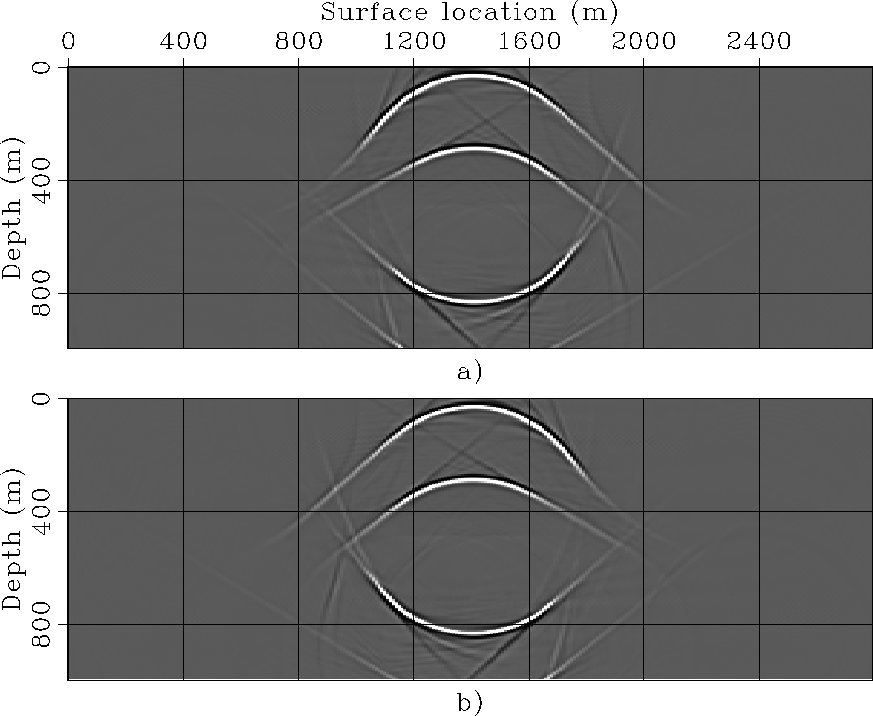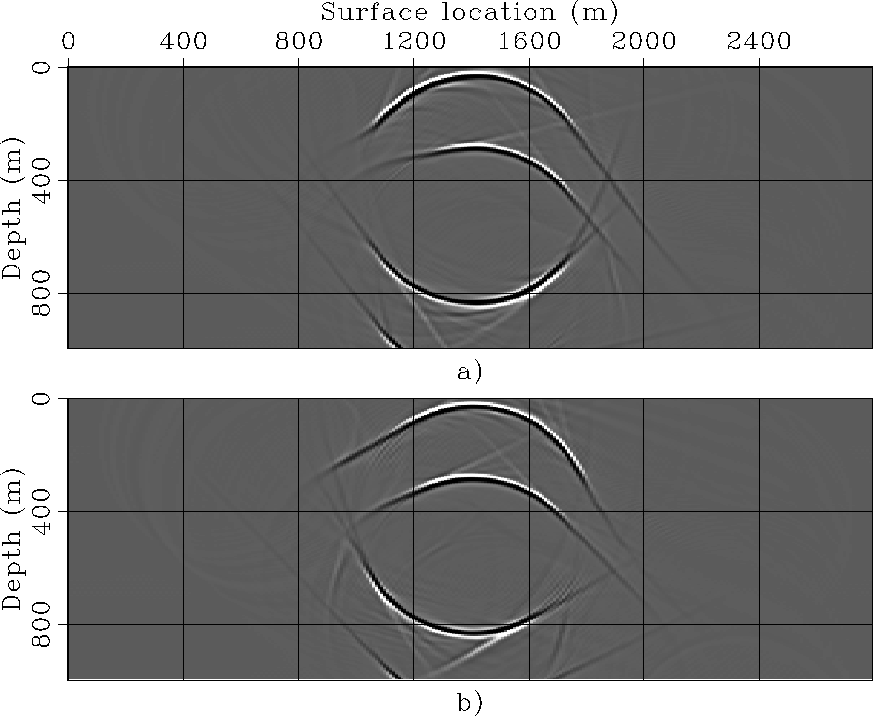




Next: Migration
Up: Prestack exploding reflector modeling
Previous: Prestack exploding reflector modeling
The modeling process starts
from the prestack image
 that is function of the image-space coordinates:
depth
that is function of the image-space coordinates:
depth  , horizontal location
, horizontal location  ,and horizontal subsurface offset
,and horizontal subsurface offset  .We then extract from the whole image a single SODCIG
identified by its horizontal coordinate
.We then extract from the whole image a single SODCIG
identified by its horizontal coordinate  ,and model the corresponding
aerial-shot data
,and model the corresponding
aerial-shot data  and
aerial-receiver data
and
aerial-receiver data  by propagating the source wavefield
by propagating the source wavefield  and the receiver wavefield
and the receiver wavefield  starting from the following initial conditions:
starting from the following initial conditions:
|  |
(1) |
| (2) |
The receiver wavefield is propagated forward in time (t),
whereas the source wavefield is propagated backward in time.
The modeled-data gathers are generated by
extracting the wavefields values at the surface
for all times and all surface locations as follows:
|  |
(3) |
| (4) |
The simple modeling procedure illustrated above generates
data useful for analyzing only flat reflectors.
A generalization of this procedure to reflectors with arbitrary dips
can be simply achieved by tilting the source function
and aligning it
along the normal to the reflector instead of along the vertical;
that is, by interpreting the offset as the geological-dip
offset instead of as the horizontal offset.
Biondi and Symes (2004)
provide a kinematic analysis of SODCIGs from dipping reflectors
that justify the
following generalization
of equations 1 and 2:
|  |
(5) |
| (6) |
and correspondingly,
|  |
(7) |
| (8) |
To illustrate the proposed modeling procedure I applied
it to a SODCIG extracted
from the prestack image of a
simple synthetic data set.
The data were modeled by using the two-way wave equation
and by assuming a constant propagation
velocity of 1 km/s
and two reflectors:
a flat reflector
below a reflector dipping by 10 degrees.
The complete data set comprises a total of 100 split-spread shot gathers.
I migrated the data twice by source-receiver migration:
once using the correct velocity and once using a velocity too slow by 10%.
Figure ![[*]](http://sepwww.stanford.edu/latex2html/cross_ref_motif.gif) ,
shows the zero-subsurface-offset sections
obtained by migration with the correct velocity
(Figure
,
shows the zero-subsurface-offset sections
obtained by migration with the correct velocity
(Figure ![[*]](http://sepwww.stanford.edu/latex2html/cross_ref_motif.gif) a),
and a velocity too slow by 10%
(Figure
a),
and a velocity too slow by 10%
(Figure ![[*]](http://sepwww.stanford.edu/latex2html/cross_ref_motif.gif) b).
b).
Sections-overn
Figure 1
Zero-subsurface-offset sections
obtained by source-receiver migration:
a) with the correct velocity,
and b) a velocity too slow by 10%.
|
|  |





Figure ![[*]](http://sepwww.stanford.edu/latex2html/cross_ref_motif.gif) shows snapshots of the wavefields obtained by
extracting an individual SODCIG from
the prestack image obtained using the correct velocity
(Figure
shows snapshots of the wavefields obtained by
extracting an individual SODCIG from
the prestack image obtained using the correct velocity
(Figure ![[*]](http://sepwww.stanford.edu/latex2html/cross_ref_motif.gif) a).
Panel a) shows the source wavefield and panel b) shows
the receiver wavefield.
Figure
a).
Panel a) shows the source wavefield and panel b) shows
the receiver wavefield.
Figure ![[*]](http://sepwww.stanford.edu/latex2html/cross_ref_motif.gif) shows the data recorded
at the surface by the aerial arrays corresponding
to the wavefields shown in
Figure
shows the data recorded
at the surface by the aerial arrays corresponding
to the wavefields shown in
Figure ![[*]](http://sepwww.stanford.edu/latex2html/cross_ref_motif.gif) .
Notice that the source wavefield (panel a) is recorded at
negative times, because it is propagated back in time.
Figures
.
Notice that the source wavefield (panel a) is recorded at
negative times, because it is propagated back in time.
Figures ![[*]](http://sepwww.stanford.edu/latex2html/cross_ref_motif.gif) -
-![[*]](http://sepwww.stanford.edu/latex2html/cross_ref_motif.gif) shows wavefields snapshots and the recorded data corresponding
to the same SODCIG used to model the data shown in
Figure
shows wavefields snapshots and the recorded data corresponding
to the same SODCIG used to model the data shown in
Figure ![[*]](http://sepwww.stanford.edu/latex2html/cross_ref_motif.gif) ,
but assuming the reflectors to be dipping by 45 degrees,
and imposing the initial conditions expressed
in equations 5 and 6.
Notice that, because of the assumed reflector dip,
the wavefields shown in
Figure
,
but assuming the reflectors to be dipping by 45 degrees,
and imposing the initial conditions expressed
in equations 5 and 6.
Notice that, because of the assumed reflector dip,
the wavefields shown in
Figure ![[*]](http://sepwww.stanford.edu/latex2html/cross_ref_motif.gif) are more asymmetric than the
the wavefields shown in
Figure
are more asymmetric than the
the wavefields shown in
Figure ![[*]](http://sepwww.stanford.edu/latex2html/cross_ref_motif.gif) ,
with the receiver wavefield
(Figure
,
with the receiver wavefield
(Figure ![[*]](http://sepwww.stanford.edu/latex2html/cross_ref_motif.gif) b)
tilted towards the right more than the source wavefield
(Figure
b)
tilted towards the right more than the source wavefield
(Figure ![[*]](http://sepwww.stanford.edu/latex2html/cross_ref_motif.gif) a).
a).
Snaps-INF-overn
Figure 2
Snapshots of the source wavefield (panel a) and the receiver
wavefield (panel b) generated by modeling an isolated SODCIG
by imposing the initial conditions expressed
in equations 1 and 2.
|
|  |





Data-INF-overn
Figure 3
The data recorded at the surface by aerial arrays and corresponding
to the source wavefield (panel a) and the receiver wavefield (panel b)
shown in Figure ![[*]](http://sepwww.stanford.edu/latex2html/cross_ref_motif.gif) . .
|
|  |





Snaps-INF-DIP-overn
Figure 4
Snapshots of the source wavefield (panel a) and the receiver
wavefield (panel b) generated by modeling an isolated SODCIG
by imposing the initial conditions expressed
in equations 5 and 6
and
assuming a reflector dip of 45 degrees.
|
|  |





Data-INF-DIP-overn
Figure 5
The data recorded at the surface by aerial arrays and corresponding
to the source wavefield (panel a) and the receiver wavefield (panel b)
shown in Figure ![[*]](http://sepwww.stanford.edu/latex2html/cross_ref_motif.gif) . .
|
|  |










Next: Migration
Up: Prestack exploding reflector modeling
Previous: Prestack exploding reflector modeling
Stanford Exploration Project
4/5/2006





![[*]](http://sepwww.stanford.edu/latex2html/cross_ref_motif.gif) ,
shows the zero-subsurface-offset sections
obtained by migration with the correct velocity
(Figure
,
shows the zero-subsurface-offset sections
obtained by migration with the correct velocity
(Figure ![[*]](http://sepwww.stanford.edu/latex2html/cross_ref_motif.gif) a),
and a velocity too slow by 10%
(Figure
a),
and a velocity too slow by 10%
(Figure ![[*]](http://sepwww.stanford.edu/latex2html/cross_ref_motif.gif) b).
b).

![[*]](http://sepwww.stanford.edu/latex2html/cross_ref_motif.gif) shows snapshots of the wavefields obtained by
extracting an individual SODCIG from
the prestack image obtained using the correct velocity
(Figure
shows snapshots of the wavefields obtained by
extracting an individual SODCIG from
the prestack image obtained using the correct velocity
(Figure ![[*]](http://sepwww.stanford.edu/latex2html/cross_ref_motif.gif) a).
Panel a) shows the source wavefield and panel b) shows
the receiver wavefield.
Figure
a).
Panel a) shows the source wavefield and panel b) shows
the receiver wavefield.
Figure ![[*]](http://sepwww.stanford.edu/latex2html/cross_ref_motif.gif) shows the data recorded
at the surface by the aerial arrays corresponding
to the wavefields shown in
Figure
shows the data recorded
at the surface by the aerial arrays corresponding
to the wavefields shown in
Figure ![[*]](http://sepwww.stanford.edu/latex2html/cross_ref_motif.gif) .
Notice that the source wavefield (panel a) is recorded at
negative times, because it is propagated back in time.
Figures
.
Notice that the source wavefield (panel a) is recorded at
negative times, because it is propagated back in time.
Figures ![[*]](http://sepwww.stanford.edu/latex2html/cross_ref_motif.gif) -
-![[*]](http://sepwww.stanford.edu/latex2html/cross_ref_motif.gif) shows wavefields snapshots and the recorded data corresponding
to the same SODCIG used to model the data shown in
Figure
shows wavefields snapshots and the recorded data corresponding
to the same SODCIG used to model the data shown in
Figure ![[*]](http://sepwww.stanford.edu/latex2html/cross_ref_motif.gif) ,
but assuming the reflectors to be dipping by 45 degrees,
and imposing the initial conditions expressed
in equations 5 and 6.
Notice that, because of the assumed reflector dip,
the wavefields shown in
Figure
,
but assuming the reflectors to be dipping by 45 degrees,
and imposing the initial conditions expressed
in equations 5 and 6.
Notice that, because of the assumed reflector dip,
the wavefields shown in
Figure ![[*]](http://sepwww.stanford.edu/latex2html/cross_ref_motif.gif) are more asymmetric than the
the wavefields shown in
Figure
are more asymmetric than the
the wavefields shown in
Figure ![[*]](http://sepwww.stanford.edu/latex2html/cross_ref_motif.gif) ,
with the receiver wavefield
(Figure
,
with the receiver wavefield
(Figure ![[*]](http://sepwww.stanford.edu/latex2html/cross_ref_motif.gif) b)
tilted towards the right more than the source wavefield
(Figure
b)
tilted towards the right more than the source wavefield
(Figure ![[*]](http://sepwww.stanford.edu/latex2html/cross_ref_motif.gif) a).
a).

![[*]](http://sepwww.stanford.edu/latex2html/cross_ref_motif.gif) .
.


![[*]](http://sepwww.stanford.edu/latex2html/cross_ref_motif.gif) .
.
